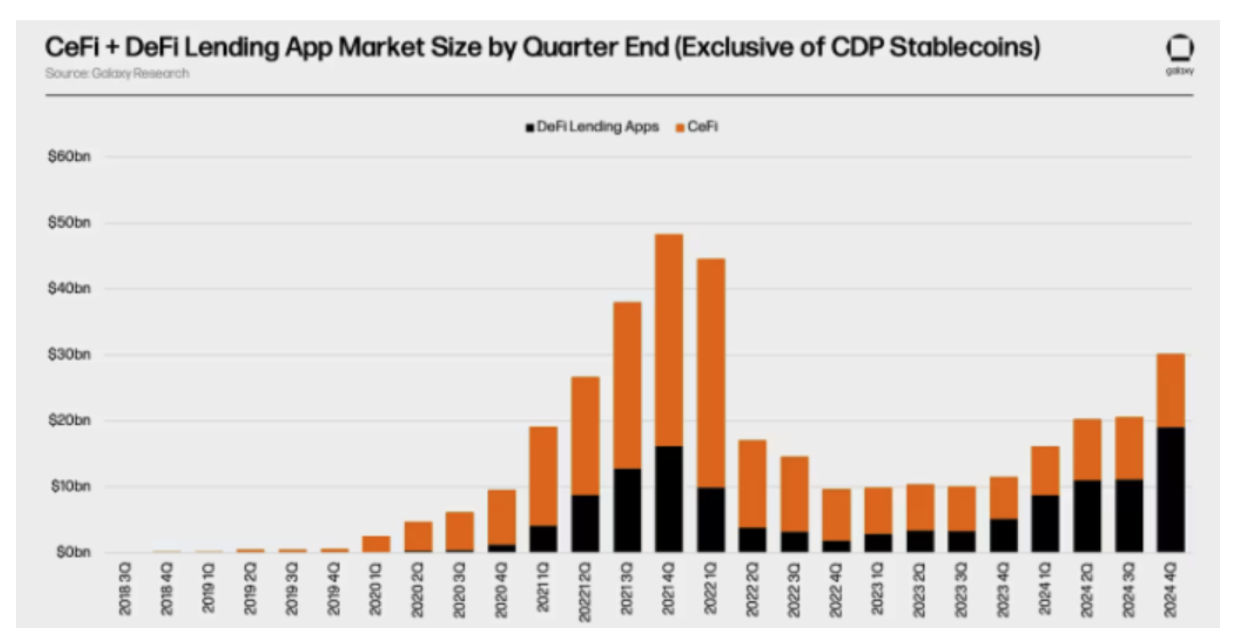Happy Uptoper! In today’s “Crypto for Advisors” newsletter, Gregory Mall, chief investment officer at Lionsoul Global, explains the evolution of bitcoin-backed lending in both decentralized and centralized financial systems.
Then, Lynn Nguyen, CEO of Saros, answers questions about tokenized stocks in “Ask an Expert.”
Thank you to our sponsor of this week’s newsletter, Grayscale. For financial advisors near San Francisco, Grayscale is hosting an exclusive event, Crypto Connect, on Thursday, October 9. Learn more.
Crypto as Collateral: What Wealth Managers Should Know About the Resurgence of the Institutional Loan Market
Lending and borrowing have long been central to financial markets — and crypto is no exception. In fact, collateralized lending emerged in the digital asset space well before Decentralized Finance (DeFi) protocols gained prominence. The practice itself has deep historical roots: Lombard lending — using financial instruments as collateral for loans — dates back to medieval Europe, when Lombard merchants became renowned across the continent for extending credit secured by movable goods, precious metals, and eventually securities. By comparison, it has taken only a short time for this centuries-old model to conquer digital asset markets.
One reason lending against crypto collateral is so compelling is the unique liquidity profile of the asset class: top coins can be sold 24/7/365 in deep markets. The speculative nature of crypto also drives demand for leverage, while in some jurisdictions Lombard-style loans offer tax advantages by enabling liquidity generation without triggering taxable disposals. Another important use case is the behavior of bitcoin maximalists, who are often deeply attached to their BTC holdings and reluctant to reduce their overall stack. These long-term holders typically prefer borrowing at low loan-to-value ratios, with the expectation that bitcoin’s price will appreciate over time.
The History of the Collateralized Lending Market
The first informal bitcoin lenders appeared as early as 2013. But it was during the ICO boom of 2016-2017 that institutional-style players such as Genesis and BlockFi emerged. Despite the crypto winter of 2018, the centralized finance (CeFi) market expanded, with retail-focused firms like Celsius and Nexo joining the fray.
The rise of DeFi in 2020-2021 further supercharged lending. Both CeFi and DeFi platforms proliferated, competing aggressively for depositors. But as competition intensified, balance sheet quality deteriorated. Several major CeFi players operated with significant asset–liability mismatches, leaned heavily on their own governance tokens to bolster balance sheets, and relaxed underwriting standards, especially with regard to haircuts and LTVs (loan-to-value ratios).
The fragility became clear in the second quarter of 2022, when the collapses of the stablecoin TerraUSD (UST) and the hedge fund Three Arrows Capital (3AC) triggered widespread losses. Prominent CeFi lenders — including Celsius, Voyager, Hodlnaut, Babel, and BlockFi — were unable to meet withdrawal demands and entered bankruptcy. Billions of dollars in customer assets were erased in the process. Regulatory and court-led post-mortems pointed to familiar failings: thin collateral, poor risk management, and opacity around inter-firm exposures. A 2023 examiner’s report on Celsius described a business that marketed itself as safe and transparent while in reality issuing large unsecured and under-collateralized loans, masking losses, and operating in what the examiner likened to a “Ponzi-like” fashion.
Since then, the market has undergone a reset. The surviving CeFi lenders have generally focused on strengthening risk management, enforcing stricter collateral requirements, and tightening policies around rehypothecation and inter-firm exposures. Even so, the sector remains a fraction of its former size, with loan volumes at roughly 40% of their 2021 peak. DeFi credit markets, by contrast, have staged a stronger comeback: on-chain transparency around rehypothecation, loan-to-value ratios, and credit terms has helped restore confidence more swiftly, pushing total value locked (TVL) back toward its 2021 record levels.(DefiLlama).

Source: Galaxy Research
Does CeFi have a role next to DeFi?
Crypto has always been driven by an ethos of on-chain transparency and decentralization. Yet CeFi is unlikely to disappear. Following the crisis, the space is more concentrated, with a handful of firms, such as Galaxy, FalconX, and Ledn, accounting for the majority of outstanding loans. Importantly, many institutional borrowers continue to prefer dealing with licensed, established financial counterparties. For these players, concerns around anti-money laundering (AML), Know Your Customer (KYC), and Office of Foreign Assets Control (OFAC) exposure as well as regulatory risks, make direct borrowing from certain DeFi pools impractical or impermissible.
For these reasons, CeFi lending is expected to grow in the coming years — albeit at a slower pace than DeFi. The two markets are likely to evolve in parallel: DeFi providing transparency and composability, CeFi offering regulatory clarity and institutional comfort.
– Gregory Mall, chief investment officer, Lionsoul Global
Ask an Expert
Q. How will Nasdaq’s integration of tokenized securities into the existing national market system and related investor protections benefit investors?
This step immediately brings three thoughts to mind — distribution, efficiency, and transparency. It’s a game-changer for everyday investors who aren’t engaging much in traditional finance. Blockchains are becoming more scalable each year, and I love the idea of efficient, composable Decentralized Finance (DeFi) use cases for tokenized securities. Plugging these assets into our industry means we’ll also see far more transparency compared to legacy systems.
Stats back this up — the global tokenized asset market is hitting around $30 billion this year, up from just $6 billion in 2022. This means broader distribution — imagine a small investor in rural America earning 5 to 7% yields on tokenized stocks without needing a broker’s blessing. Moving from traditional finance to DeFi, I’ve seen myself how blockchains can optimize while also being more transparent and inclusive. This isn’t just hype — it’s about helping more people build wealth through smarter, digitized tools that level the playing field.
Q. What are the challenges investors might face if the Securities and Exchange Commission (SEC) approves Nasdaq’s proposal to trade tokenized securities?
It’s not going to all be plain sailing. Firstly, there will be technical hurdles that need to be overcome, and these will affect timeframes as well as user experience for investors. Mixing blockchain infrastructure with legacy systems is not straightforward, and this will likely affect early adopters, as well as the initial prevalence of liquidity.
Early investors will also need clearer guidance on regulation. There’s a need for crystal-clear guidance on token rights, as investors may face issues related to events such as dividends or voting. When introducing new technologies, it is also essential to take security very seriously. Cyberattacks have spiked 25% year-over-year, and we’ve all seen the high-profile cases related to blockchains. Though you would assume this would be a priority for Nasdaq.
All of these issues are solvable as far as I’m concerned. So I’m not too worried.
Q. Nasdaq has mentioned Europe’s trading of tokenized stocks is “raising concerns” because investors can access tokenized U.S. equities without actual shares in companies. How will Nasdaq’s proposal to offer “the same material rights and privileges as do traditional securities of an equivalent class” benefit investors?
Here, we’re talking about benefits that include access to the same rights as traditional securities — voting, dividends, and equity stakes. In Europe, investors have been able to acquire securities without full rights, which I view as similar to holding an exclusive non-fungible token (NFT) without gaining the membership benefits it grants. Imagine owning a Cryptopunk but not having access to the PunkDAO and the venture opportunities available to holders.
Nasdaq is essentially trying to prevent investors from getting shortchanged. This is a major benefit because you are not just getting access to a more dynamic but limited version of the asset — you’re still getting all of the perks. When I think of the potential here, it’s exciting — imagine fully fledged stocks with 24/7 trading, lower fees, and significantly shorter settlement times.
Keep Reading
- BlackRock’s spot ETF IBIT now allows for in in-kind creation and redemptions of bitcoin.
- Canadian Royal Mounted Police have dismantled a crypto trading platform along with a seizure of over $56 million for operating illegally.
- The Bank of England Governer has stated the stablecoins could form a major shift in the banking system.
Discover more from Stay Updated Finance News
Subscribe to get the latest posts sent to your email.
